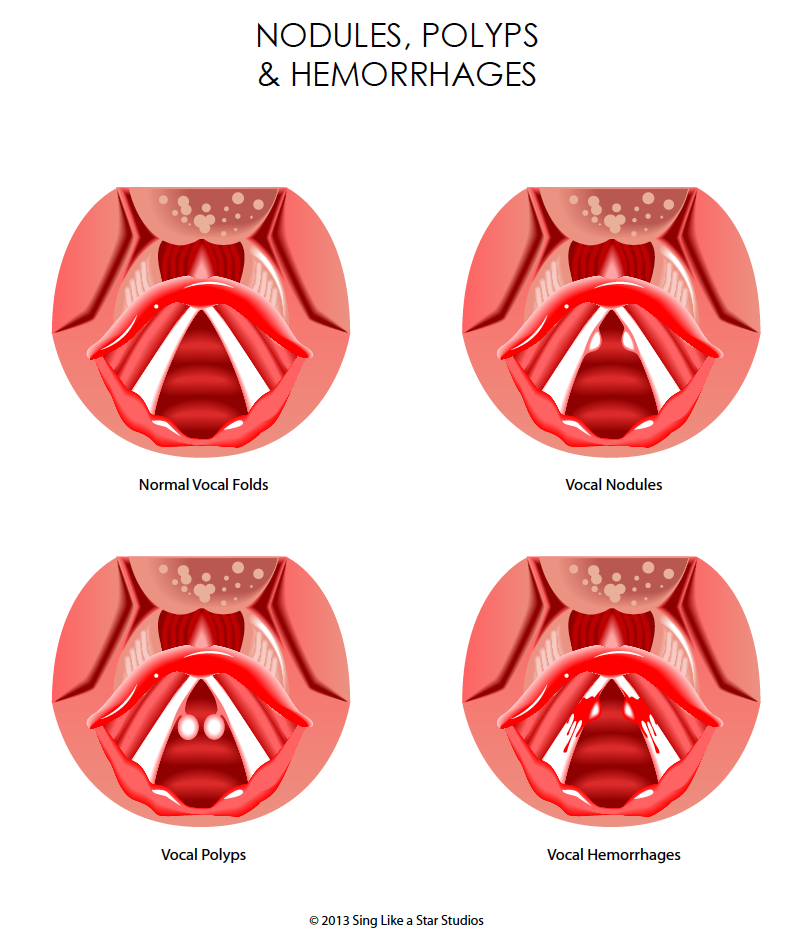“The flame that burns twice as bright burns half as long.”
― Lao Tzu, Te Tao Ching
Nodules, Polyps, Hemorrhages, and Other Conditions
Swelling of the vocal folds due to illness, fatigue, or poor vocal technique prevents midline vocal fold closure resulting in an imbalance in the system as air pushes through. Manifestations of trauma such as nodules, polyps and hemorrhages are the result of extended vocal abuse and make midline closure impossible. Singing too loudly, too long, or with too much air pressure will result in edema, or swelling of the fold
Here is a great YouTube video explaining several manifestations of vocal trauma:
https://www.youtube.com/watch?v=YFs4etPQd7M
CYSTS
Definition: A cyst is a growth that forms beneath the surface layer of the vocal fold mucosa, causing a gap between the vocal folds and preventing normal vibration; it may cause some portion of the vocal fold mucosa to become stiff, preventing normal vibration and affecting voice quality and ease of vocal production. Cysts are typically found on one vocal fold, but can be found on both. It is also common for a nodule to form on the opposite vocal fold in response to the additional pressure from the cyst. Hemorrhages and polyps are examples of cysts.
Indications: Indications may include abnormal voice quality, vocal fatigue, discomfort or pain associated with increased talking, interference with breathing, and a sense of something irritating in the throat that needs to be cleared or coughed away. The sound of the voice ranges from normal to breathy to extremely rough and hoarse and often worsens with increased voice use.
Causes: Cysts can occur with minute bleeding (hemorrhage) in the mucosa of the vocal fold. The bleeding resolves but leaves a tiny bit of scar tissue, and the cyst forms around it. The cyst may be solid, filled with fluid, or even filled with blood. The initial bleed may be caused by a relatively short period of intense vocal fold vibration, such as severe coughing or screaming.
Contributing factors may include taking aspirin and non-steroidal anti-inflammatory drugs.
Treatment: Cysts may resolve by simply reducing vocal fold impact for a time. However, they often require surgical removal. Pre and post-surgical functional voice therapy usually improves the surgical result.
Prevention: The best preventive steps are to acquire a good foundation in correct vocal technique and to use caution regarding over-use of the voice. Do not shout or sing in loud or outdoor environments, limit the use of the voice in daily speaking or singing, don’t push or force the voice, and do not sing or speak at all if there is any evidence of vocal fold swelling. Singers should be taking a weekly voice lesson with a teacher who understands the concepts of mix and balanced registration, and should vocalize daily to ensure good vocal function.
Hoarseness or breathiness that lasts for more than two weeks may signal a voice disorder and should be followed up with an otolaryngologist or ENT.
NODULES
Definition: Also known as “Singer’s Nodes”, nodules are callous-like swellings that form just below the epithelial surface of the vocal folds. Nodules begin as symmetrical swellings on both sides of the vocal folds and progress to a hardened, callous like growth of tissue on one or both vocal folds. A nodule usually appears on the junction of the anterior 1/3 or the posterior 2/3 of the vocal fold where contact between the folds is most forceful.
Indications: Nodule formation creates a gap between the vocal folds, allowing air to escape and preventing normal vibration. The calluses that form on the vocal folds prevent the folds from meeting at the midline, producing a deformity of closure and stiffening the mucosal tissue, causing irregular vibration and a raspy sound. The quality of the voice may range from normal to breathy to very hoarse and strained. The inability to sing high and soft notes is one of the hallmarks of nodules. When the individual tries to sing high and soft there is a delay in the onset of the sound, with an audible air escape, and then the sound starts abruptly.
Other indications include abnormal voice quality, limited pitch and volume, vocal fatigue, and discomfort when singing or speaking.
Causes: Nodules are benign (noncancerous) growths that are caused by vocal abuse. Nodules typically occur in people who use their voice in an intense manner over an extended period of time. They are a natural response to increased trauma, similar to calluses on the hands. Vocal abuse can be defined as strenuous practices such as yelling, over-singing, talking in loud environments, pulling the lower register too high, singing too hard or with too much air, and forcing the voice, all symptomatic of an excess of air pressure.
Over time, repeated abuse of the vocal folds results in soft, swollen spots on each vocal fold. These spots eventually develop into harder, callous-like growths. The nodules become larger and stiffer as vocal abuse continues.
Treatment: Treatment usually involves vocal rest and re-training using vocally therapeutic exercises. In advanced cases surgery may be required. Removal of the nodules may temporarily solve the problem but they tend to return as soon as a singer begins to sing again with his or her original vocal habits. These new habits must be maintained for life if the singer wishes to avoid further issues. Surgery is useless unless the singer has a committed attitude toward changing the habits that created the issue in the first place.
Prevention: The best preventive steps are to acquire a good foundation in correct vocal technique and to use caution regarding over-use of the voice. Do not shout or sing in loud or outdoor environments, limit the use of the voice in daily speaking or singing, don’t push or force the voice, and do not sing or speak at all if there is any evidence of vocal fold swelling. Singers should be taking a weekly voice lesson with a teacher who understands the concepts of mix and balanced registration, and should vocalize daily to ensure good vocal function.
Hoarseness or breathiness that lasts for more than two weeks may signal a voice disorder and should be followed up with an otolaryngologist or ENT.
POLYPS
Definition: Polyps are benign lesions of the larynx located on the phonating edge of the vocal folds that prevent the vocal folds from meeting at the midline. Polyps appear on either one or both of the vocal folds as a swelling or bump, a stalk-like growth, or a blister-like lesion. Most polyps are larger than nodules and may be called by other names, such as polypoid degeneration or Reinke’s edema. The best way to think about the difference between nodules and polyps is to think of a nodule as a callous and a polyp as a blister.
Indications: Polyps can interfere with voice production and may produce a hoarse, breathy voice that tires easily.
Causes: Polyps may be caused by long-term vocal abuse but may also occur after a single, traumatic event to the vocal cords, such as yelling at a concert. Long-term cigarette smoking, hypothyroidism, and GERD may also cause polyp formation.
Vocal abuse may include allergies, smoking, tense muscles, over- singing, talking loudly, shouting, in loud environments and outdoors (avoid cheerleading if you want to sing!), and drinking caffeine and alcohol (dehydrates the tissues of the body). One of the cofactors in the cause of these lesions may be laryngeal reflux disease.
Treatment: Polyps, like nodules may respond to rest and vocal rehabilitation, but tend to reappear if vocal habits are not changed and permanently maintained. Surgery is an option if the polyps do not respond to rest and vocal therapy.
Prevention: The best preventive steps are to acquire a good foundation in correct vocal technique and to use caution regarding over-use of the voice. Do not shout or sing in loud or outdoor environments, limit the use of the voice in daily speaking or singing, don’t push or force the voice, and do not sing or speak at all if there is any evidence of vocal fold swelling. Singers should be taking a weekly voice lesson with a teacher who understands the concepts of mix and balanced registration, and should vocalize daily to ensure good vocal function.
Hoarseness or breathiness that lasts for more than two weeks may signal a voice disorder and should be followed up with an otolaryngologist or ENT.
Here is a YouTube video with singers with polyps phonating at various pitches:
https://www.youtube.com/watch?v=emCWkC_a91s&list=UUYi00BEbaf4RXd3fXfjeEpA
HEMORRHAGE
Definition: A hemorrhage is the result of the rupture of a blood vessel on the vocal fold that creates bleeding into the mucosal covering of the fold. The accumulation of blood under the surface of the vocal fold makes the fold stiff, making vibration more difficult. The amount of the bleed can vary greatly but often it is large enough to prevent vibration of the affected vocal fold altogether. Sometimes the bleed becomes encapsulated into a cyst or polyp.
Here is a YouTube video showing a vocal fold hemorrhage:
https://www.youtube.com/watch?v=e4gKT7oOPEk
English pop singer Adele has been diagnosed with vocal fold hemorrhages and has had to cancel performances as a result.
Indications: A hemorrhage is typically an acute (sudden) event, and the voice may suddenly “cut out” or become very weak, breathy, or rough. Indications may include sudden decrease in voice quality, a loss of pitch range, loss of volume, and loss of vocal control. A person experiencing a hemorrhage may suddenly be unable to produce a sound. This resolves over time as the blood accumulation subsides. Small hemorrhages may cause only slight changes in voice quality, which could go unnoticed.
Causes: Vocal fold hemorrhage is caused by vocal trauma due to over-use or shock. A hemorrhage occurs either when there is sudden high impact or a prolonged traumatic impact to the vocal folds, and is more likely to occur when the blood vessels in general are already more susceptible to hemorrhage. This may happen when Aspirin products (an anticoagulant), or alcohol (a vasodilator), are used and is more common in women during the menstrual cycle.
Treatment: Vocal rest, therapy, and voice re-habilitation may resolve the issue, but if the underlying cause of poor vocal habits is not resolved the hemorrhage may return.
Prevention: The best preventive steps are to acquire a good foundation in correct vocal technique and to use caution regarding over-use of the voice. Do not shout or sing in loud or outdoor environments, limit the use of the voice in daily speaking or singing, don’t push or force the voice, and do not sing or speak at all if there is any evidence of vocal fold swelling. Singers should be taking a weekly voice lesson with a teacher who understands the concepts of mix and balanced registration, and should vocalize daily to ensure good vocal function.
Hoarseness or breathiness that lasts for more than two weeks may signal a voice disorder and should be followed up with an otolaryngologist or ENT.
GRANULOMA
Definition: A granuloma is a benign growth that typically occurs in the posterior (back) part of the larynx, either directly on the vocal fold or on one of the mucosal surfaces nearby. A lesion that is not directly on the vocal fold may not interfere with voice quality, but can be very irritating and painful. A large enough lesion may obstruct the airway. Singer John Mayer has been diagnosed with granuloma and has recently undergone a second surgery.
Here is a YouTube video showing what a granuloma looks like:
https://www.youtube.com/watch?v=8XQIksCgOGU&feature=c4Cysts-overview&list=UUYi00BEbaf4RXd3fXfjeEpA
Indications: The growth may prevent glottal closure, causing vibration to be weak or non-existent. This could cause a weak or breathy voice, or frequent “breaks” in the voice, or the lesion may interfere with vibration, causing a rough, irregular sound. The voice may fatigue easily and become worse with continued use.
Causes: A granuloma is actually one of the body’s ways of healing or protecting itself from an inflammatory or infectious process. It is believed to be related to an infectious process within the cartilage of the larynx. Granulomas can occur in a number of ways, but most are related to some acute or chronic injury, such as trauma from intubation during surgery, an extended bout of coughing or other vocal trauma, chronic acid reflux GERD/LPRD, chronic mild trauma such as frequent throat-clearing, and poor vocal technique while singing.
Vocal fold trauma or impact will usually make the granuloma worse. Loud or excessive talking, throat-clearing, coughing, grunting, and effortful vocal production can all cause the granuloma to grow larger.
Treatment: Surgery is often prescribed for granuloma. However, recurrence of granuloma is common, even after surgery. Here are some non-surgical treatments:
1. Anti-reflux medications are prescribed to eliminate any burning from acid reflux. Dietary and lifestyle changes may alleviate GERD/LPRD
2. A short course of steroids is prescribed to reduce the inflammation and, hopefully, the size of the granuloma
3. Antibiotics are given to alleviate any infectious process
4. Speech therapy is initiated to help identify sources of high vocal fold impact, and to teach techniques to reduce the impact while talking
5. Re-habilitation of the singing voice with vocal technique that minimizes excessive air pressure
Prevention: The best preventive steps are to acquire a good foundation in correct vocal technique and to use caution regarding over-use of the voice. Do not shout or sing in loud or outdoor environments, limit the use of the voice in daily speaking or singing, don’t push or force the voice, and do not sing or speak at all if there is any evidence of vocal fold swelling. Singers should be taking a weekly voice lesson with a teacher who understands the concepts of mix and balanced registration, and should vocalize daily to ensure good vocal function.
Hoarseness or breathiness that lasts for more than two weeks may signal a voice disorder and should be followed up with an otolaryngologist or ENT.
PRESBYLARYNGIS
Definition: This is a condition that is caused by thinning of the vocal fold muscle and tissues with aging.
Indications: The vocal folds have less bulk than a normal larynx and therefore do not meet in the midline. As a result, the singer has a hoarse, weak, or breathy voice.
Causes: Deterioration of the muscles and tissues due to aging.
Treatment: This condition can be corrected by injection of fat or other material into both vocal folds to achieve better closure.
Prevention: Daily vocalization can prevent many of the conditions associated with aging and preserve a youthful sounding voice well into the advanced years.
MUSCLE TENSION DYSPHONIA
Dysphonia dys·pho·ni·a: Difficulty in speaking due to a physical disorder of the mouth, tongue, throat, or vocal folds.
Definition: Muscle tension dysphonia occurs when excessive laryngeal muscle tension squeezes the vocal folds and surrounding muscles into a “fist” configuration, preventing air from moving through the vocal folds to enable normal vibration.
Indications: Indications include throat tightness, muscle aches in the neck while talking or singing, rough, hoarse voice that gets worse with continued use, throat or neck pain when talking, excessive use of the false vocal folds and surrounding supraglottic musculature, and persistent straining and pressing of the voice. Nodules may also be present on the true vocal folds. The voice is reduced to a “squeaky” sound.
Causes: MTD occurs when the external laryngeal muscles are either too tight or are over-used in the speaking or singing voice. When this happens the vocal folds do not function properly. Medications can also contribute to dysphonia: Inhaled steroids, testosterone, decongestants, antihistamines, anticoagulants, and some antipsychotics can be problematic.
Treatment: These conditions respond to speech therapy with a qualified speech language pathologist. Surgery is not indicated if the patient responds to speech therapy and if new habits of speaking are maintained.
Prevention: Correct speaking and singing habits with relaxation of the laryngeal musculature to create “flow phonation”. Refraining from the medications listed above that may contribute to the issue.
ACID REFLUX
Definition: Acid reflux is a condition in which stomach acids rise up into the esophagus because the valve that separates the stomach contents from the esophagus is faulty. The stomach produces strong acids and enzymes (gastric juices) which are used in food digestion. The inner lining of your stomach has several mechanisms to protect itself from the effect of the gastric juices on itself, but the lining of the esophagus does not. The valve that stops the gastric juices from going up the esophagus is called the lower esophageal sphincter. The esophageal sphincter lies at the junction where the stomach and the esophagus join. When the lower esophageal sphincter becomes weakened gastric juices can seep upward into the esophagus.
Many people have acid reflux problems occasionally; in the majority of cases this is harmless. If the problem becomes persistent and goes untreated, heartburn can develop into GERD (Gastroesophageal Reflux Disease). Gastroesophageal reflux disease (GERD) is a condition in which the stomach contents (food or liquid) leak backwards from the stomach into the esophagus (the tube from the mouth to the stomach). This action can irritate the esophagus, causing heartburn and other symptoms.
In chronic and severe cases the esophagus can become scarred, leading to difficulty swallowing. In severe cases the risk of developing cancer of the esophagus increases significantly.
Indications: The symptoms of acid reflux are:
1. Asthma as gastric juices seep upwards into the throat, mouth and air passages of the lungs
2. Chest pain
3. Dental erosion due to acidic substances on the teeth
4. Dysphagia – difficulty swallowing
5. Heartburn – a burning feeling rising from the stomach or lower chest towards the neck
6. Hoarseness
7. Regurgitation – bringing food back up into the mouth
Reflux of acid into the larynx can have detrimental effects on the voice; when acid bathes the vocal folds and larynx, the tissues become red and inflamed, and singing becomes difficult.
Individuals with acid reflux may have hoarseness and a persistent cough that can lead to vocal fold lesions. As the vocal folds begin to swell from acidic irritation their normal vibration is disrupted. Even small amounts of exposure to acid may be related to significant laryngeal damage.
This disruption in the vibratory behavior of the vocal folds will often produce a change in the singing or speaking voice. When a singer or speaker encounters an undesirable vocal sound the first impulse is to compensate by changing vocal production, resulting in potentially abusive vocal behaviors. This can exacerbate the original symptoms through excessive muscular tension and can eventually lead to the development of vocal fold pathologies.
Causes: Acid reflux may be caused by several factors including hiatus hernia (malfunction of the stomach valve), obesity (being overweight), and poor eating habits. Poor eating habits, which can make reflux worse, include night eating, overeating, and consuming food or drinks that promote stomach acid production, such as spicy, fatty, or fried foods, acidic foods (tomato sauce, orange juice), soda, coffee, tea, chocolate, mints, and alcohol. In addition, using tobacco products in any form promotes stomach acid production.
Treatment: Lifestyle changes sometimes help prevent symptoms of gastro esophageal reflux disease, or GERD. Because fatty foods, mints, chocolates, alcohol, nicotine, and caffeinated beverages such as coffee or colas relax the lower esophageal sphincter, you may be able to reduce the amount of acid reflux you experience by avoiding these foods. Carbonated drinks, citrus fruits and juices, spicy foods, and tomato sauce may irritate the lining of your esophagus and make the effects of GERD more severe. Cutting out these foods helps some people who have GERD.
You may help reduce reflux by quitting smoking, wearing loose clothing, eating smaller meals, not lying down for at least three hours after you eat, and losing weight if you are overweight. Some people are able to prevent symptoms at night by raising the head of their bed with 6-inch blocks or by sleeping on a special wedge-shaped pillow that elevates the upper part of the body. Sleeping on your left side may also lessen symptoms.
Some medications, such as birth control pills and drugs for osteoporosis may cause reflux as a side effect. If drugs you are taking seem to be causing heartburn, talk with your doctor about other medications you might be able to use instead.
Prevention: Utilizing the lifestyle changes outlined above can minimize or prevent acid reflux.
Any vocal issue that persists more than two weeks should be investigated by a visit to an ENT (ear, nose and throat doctor) or an otolaryngologist.
You can view the following YouTube videos to see the vocal dysfunction in action:
https://www.youtube.com/watch?v=s75L5sJY5e4
https://www.youtube.com/watch?v=qEKW7IQtfb4
https://www.youtube.com/watch?v=VrugdiVVTDU
https://www.youtube.com/watch?v=yWNNAbdtBDs
https://www.youtube.com/watch?v=LHHld976uek
https://www.youtube.com/watch?v=m29zTLkCEPU
https://www.youtube.com/watch?v=rhcHUlKrbnA
A Vocal Fold Polyp is removed



